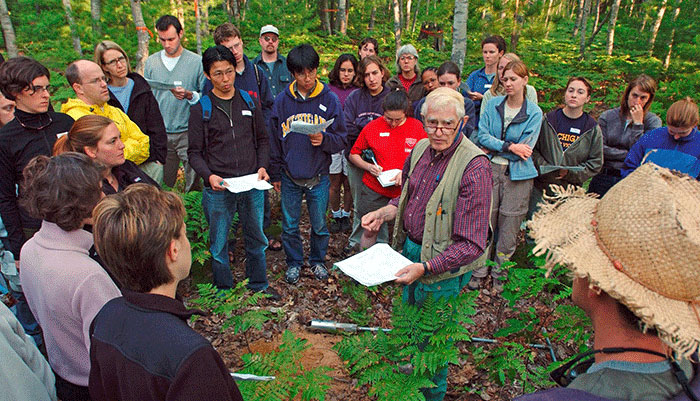Democracy, Civic & Global Engagement | Sustainability & Climate Action
Cultivating the Perfect Guidebook through Teaching

University of Michigan Press publishes a rich collection of books that explore the history, culture, and environment of the Great Lakes region. These books are collaborative efforts with campus partners. A particularly fruitful example involves a book that has been in print since 1913 and a beloved undergraduate course taught in the School for Environment and Sustainability.
Woody plants form the scaffolding of natural communities. The study of woody plants may be the only time people get to actually see what they’re trying to save.
Originally published as a University Bulletin, Michigan Trees first appeared under the University of Michigan Press imprint in 1931. Since then, the book has been updated and expanded multiple times, with a new edition due in 2020. Michigan Trees has always been an important resource for Michigan’s citizenry and professional readers. Today, virtually all public libraries in Michigan own copies of the book, and it is part of the training curriculum run by the USDA and Michigan DNR.
Beginning in the 1960s, the book also became indelibly linked to the classroom when it was adopted by U-M’s Woody Plants course, developed by Professors Burton V. Barnes and Warren “Herb” Wagner to teach students about the plant life in the diverse landscapes around Ann Arbor. “Woody plants form the scaffolding of natural communities,” Professor Warren “Herb” Wagner once said, “The study of woody plants may be the only time people get to actually see what they’re trying to save.”
“My first semester I took ‘Woody Plants’ with Burt Barnes and Herb Wagner. . . I was in heaven! I couldn’t BELIEVE what was expected of us in Woody Plants. Long afternoons in the field—sun, rain, sleet or hail— and we had them all. And long hours in the indoor lab memorizing soggy leaves and twigs in light-green lab trays. There were compelling lectures, too. I had to write furiously to keep up with Burt and was amazed at Herb’s ability to entertain. I just loved it.”
In the following decades, Michigan Trees accommodated the demands of the classroom, including sections on climate change, the impact of invasive species, and the evolution of forests across our region. Michigan Trees is now viewed as one of the country’s preeminent botanical guides, used in courses at the University of Wisconsin, University of Minnesota, and University of Maryland, among other schools. The New York Botanical Garden, Los Angeles County Arboretum, and even the Conservatory and Botanical Garden of the City of Geneva have copies—some 4,000 miles away from the region covered by the book.
Michigan Trees (2004) By Burton V. Barnes and Warren H. Wagner, Jr.
Michigan Shrubs and Vines (2016) By Burton V. Barnes and Warren H. Wagner, Jr.